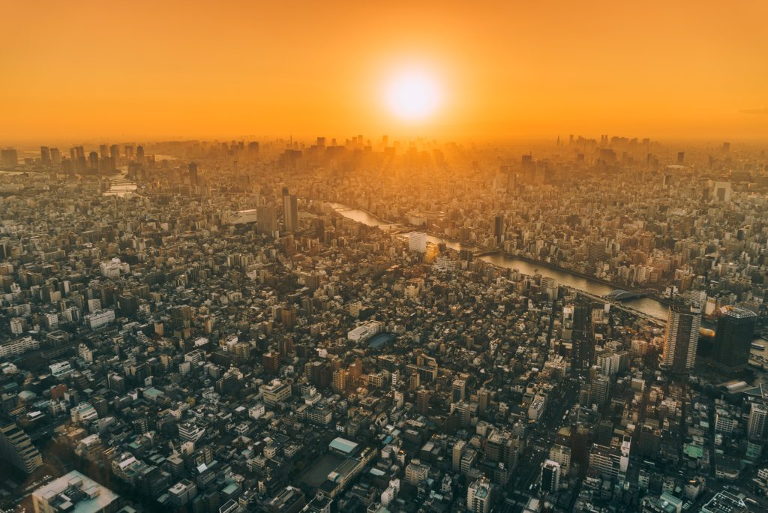As the Abe government and major corporations fail to take meaningful steps to reduce emissions, Japanese citizens are working to pick up the slack
Japan is no stranger to extreme weather events, nor to developing massive infrastructural defenses against them. At the beginning of the millennium, faced with a capital city susceptible to cataclysmic flooding, the Japanese government poured millions of dollars into the creation of Tokyo’s Metropolitan Area Outer Underground Discharge Channel, the largest underground water diversion system in the world. An impressive cathedral-like structure, the channel can divert the equivalent of an Olympic-sized swimming pool into the Edo River every two seconds. It is a masterpiece of civil engineering and a testament to sheer human determination to innovate our way out of any existential threat.
But even with the support of the Channel’s miles of tunnels, Tokyo today—not in some distant climate future, but right now—still faces the prospect of a flood severe enough to require the immediate evacuation of up to 1.78 million people. As climate change pushes Japan’s natural disasters to new extremes, efforts to out-design increasingly lethal weather patterns may be in vain. Rather than attempting to treat the symptoms of climate change, Japan must tackle its root causes.
This was the charge levelled at the Japanese government following the devastating events in the summer of 2018, which saw the country, which generates 83% of its energy from fossil fuels, brought to its knees by climate change-driven extreme weather. Over the month of July, huge swathes of southwestern Japan were inundated with water. Flash flooding and mudslides took the lives of over 200 people. Many regions set rainfall records by enormous margins.
As the rain fell, a heatwave was simultaneously gaining strength, burning through still-flooded prefectures and killing at least 65 people in a single week. 65 kilometres northwest of Tokyo, in the city of Kumagaya, the mercury had just hit 41.1 degrees Celsius—the highest temperature in Japan ever recorded. Just one month later, the Typhoon Jongdari made landfall, with 120 km/h winds injuring 24 and driving the evacuation of thousands. It was only a few short weeks before Typhoon Jebi—Japan’s strongest storm in 25 years—slammed into Kyoto, killing 7 and smashing a 2,591-tonne tanker into a road bridge. Completing a trilogy of destruction, Typhoon Trami followed hot on Jebi’s heels, cutting power to 750,000 homes and evacuating over 380,000. This time the winds reached 216 km/h.
This was record-breaking weather, and the media responded accordingly, running stories about the growing impact of climate change on Japan’s already storm-prone archipelago. Aired in an atmosphere of crisis, the stories ended with the familiar climate imperative: ‘Act now!’ But in the same year that unprecedented floods and rising temperatures wrought havoc on the country, the Japanese government released a report with a bizarre angle on climate change. Jointly produced by five government agencies, the report assured its readers of the opportunities for businesses to ‘take advantage’ of climate change. How? By building products to make heatwave-stricken homes and offices more comfortable, or designing sophisticated financial instruments to manage the economic risks of abnormal weather events.
Examples included Japan-based Dexerials Corporation’s heat-ray reflective window film, a product that promises to shield buildings from extreme heat, along with Kokusai Kogyo’s GPS technology that provides land management tools for farms struck by increasingly erratic weather-related disasters. The report made no mention of fossil fuels, carbon emissions or waste reduction, but did note that new varieties of oranges able to tolerate the heat are now being grown in Ehime, a prefecture that suffered 25 deaths and millions of dollars of damage in the 2018 floods.
While such official responses to climate change are deeply out of touch with the urgency of the situation, it wasn’t long ago that Japan’s energy sector was poised to lead a worldwide energy transition. In 1997, when world leaders came together to sign the historic Kyoto Protocol, Japan was synonymous with fighting climate change. But its drive for clean energy faltered in 2011, when the earthquake and tsunami that devastated the country’s eastern shores delivered a fatal blow to the Fukushima Daiichi Nuclear power plant, in what would become the world’s biggest nuclear disaster since Chernobyl.
In the ensuing panic, the country’s nuclear reactors, which had been generating just under a third of Japan’s energy, were shut down immediately. The tide of public opinion seems to have turned against nuclear energy for good. In 2014, 59% of the public opposed switching the reactors back on. To date, nine reactors have been brought back online since the Fukushima disaster, bringing nuclear’s contribution to Japan’s energy mix up to 3%.
This disaster was a boon for the fossil fuel industry, as coal and oil were seen not only as safer than nuclear energy, but also a more reliable alternative to still-developing renewable energy sources. Japan’s reliance on imported oil and coal soared, and it took less than a year for Japan to become the world’s second biggest importer of fossil fuels. More than two decades after the adoption of the Kyoto Protocol, just under 15% of Japan’s energy needs are met by non-carbon sources.
Comparing the Fukushima disaster with the even greater threat posed to Japan by climate change allows a certain irony to emerge. Not only were the Japanese government’s actions after Fukushima driven by all the urgency that has been so sorely lacking in their response to climate change, they also set the country on a path of self-destruction, as continued reliance on fossil fuels continues to warm our planet. But when it comes to Japan’s climate inertia, the impact of Fukushima is just one part of the story. To understand why the fossil fuel industry maintains its iron grip on Japan today, we need to look beyond the aftermath of this disaster and to ongoing conditions.
The long road to decarbonization
Japan currently holds the most solar technology patents in the world, and is the leading manufacturer of photovoltaic devices, providing nearly half of the world’s quota. The islets and channels in its Western coastal regions offer significant tidal energy generation potential. Moreover, as a mountainous island surrounded by sea, Japan is perfectly placed for the development of wind technology. But the Ministry of Economy, Trade and Industry failed to award a single contract last year to a solar energy supplier to deliver energy to consumers, citing costs that exceeded government targets. Plans announced in 2013 to install tidal turbines along Japan’s coastline have not yet come to fruition, and public doubts about the reliability of wind power have been exploited by regional electricity companies who, citing variability issues with wind-generated electricity, are sticking to the ‘safe bets’ of oil and coal.
Meanwhile, the Abe government refuses to take the lead on emissions reductions. The Japanese government’s ‘Long-Term Energy Supply and Demand Outlook’ pledged to increase the amount of energy supplied by renewables from 15% to 22-24% by 2030: a goal that was described as ‘modest’ by news outlets, and more bluntly by the country’s own Foreign Minister as ‘lamentable.’ In negotiations leading up to the 2015 Paris Agreement, countries were asked to present their own national emissions reduction plan. Each plan would work towards an overall global reductions target, while taking economic and infrastructural differences between countries into account. So far, so good—except Japan’s plan for a 26% reduction from 1990 levels by 2030 was widely criticized for falling far short of the plans produced by other industrialised nations. For comparison, the European Union is chasing a minimum target of 40%.
With the national climate strategy plagued by inertia, some Japanese businesses have begun mobilising to accelerate the energy transition. Last July, as floods swallowed the south of the country, a handful of companies, local governments and NGOs joined together to form the Japan Climate Initiative, a network independent of the national government and committed to fostering productive climate action. JCI’s mission statement is simple: ‘We believe that Japan can and should play a greater role in the world in realizing a decarbonized society.’
As of March 2019, the network includes 350 companies, and counts giants SoftBank and Fujifilm among its members. According to the network’s website, over 50 Japanese companies have committed to setting ‘science-based targets’ to reduce emissions. Many are signing on to RE100, the pledge to generate 100% of a company’s energy from renewables, and some local governments have even declared a goal of zero emissions.
But for many businesses, the decision to do without fossil fuels would doom them to a competitive disadvantage severe enough to threaten their existence. Instead, major Japanese corporations seek to place the burden of change on consumers. The Japanese technology giant Hitachi, for example, claims that since the majority of their emissions result from the use of their products by consumers, their hands might as well be tied. ‘It’s really a challenge,’ a Hitachi spokesman lamented, echoing Sony’s proclamation that the real problem lies in families’ failure to teach children about curbing carbon emissions. Never mind that in the last fiscal year, Sony Japan’s carbon dioxide emissions accounted for 75% of the company’s total global emissions—an increase from the previous year.
Such rhetoric serves to mask the driving force of ceaseless competition for profit that incentivizes the production of carbon-intensive and environmentally-destructive goods in the first place. This competitive logic prevails even as corporations are required to disclose their environmental impact. Revelations that Japanese carmakers Nissan, Suzuki Motor, Mazda and Yamaha have been faking vehicle emissions data could be just the tip of the iceberg of climate malfeasance.
With the corporate sector at best an unreliable ally in the fight to reduce emissions, Japanese citizens have been working to pick up the slack. But this burgeoning climate movement faces its fair share of challenges too.
Japan’s burgeoning climate movement
On February 22, 2019, 20 young people from Japan’s Fridays For Future chapter gathered in front of Tokyo’s Diet Building holding placards and shouting their support for climate justice. Though a far smaller spectacle than the crowds that gathered in Paris and Sydney, this act of rebellion marks a significant step forward in the fight to bring climate legislation to Japan. Public demonstrations in the country are uncommon, usually arising in response to only the most contentious social issues.
One of the largest gatherings of Japanese protestors took place in 2012, in response to the restarting of a nuclear reactor 16 months after the Fukushima disaster: around 100,000 people took to the street to protest the decision to bring the reactor back online. I spoke to a member of an online Japanese climate activist group, who put the numbers into perspective: ‘It was the largest demo in several decades… [and] it wasn’t that [big],” he noted. ‘Japan is a country of 127 million. Even considering the logistics, the greater Tokyo area is home to 30 million.’ But as it seeks to expand its reach into mainstream Japanese society, the climate movement will have to overcome a prevailing sense of apathy. Some see this apathy as unsurprising for a generation that came of age during Japan’s ‘lost years’ of economic decline.
This apparent lack of political engagement is compounded by the perceived social costs of protesting. A member of the group Climate Youth Japan suggested that ‘not only young people but also Japanese people generally feel that the hurdles to participating in [protest] actions are high.’ Views of social change in Japan tend to hew to tradition: let the government lead and citizens follow. In such a staid political climate, taking a stand as an activist means taking a serious risk. As the Japanese saying goes, ‘the nail that sticks out gets hammered down.’ Street protests struggle to garner support in a culture that values adherence to the official channels of parliamentary politics.
As a member of an online Japanese climate activist group explained, ‘there’s a vote where everyone gets a chance to choose a representative. Then you should petition and call your representative. If a handful of people gather in the street to forcefully set the agenda on a topic, many see it as an unfair process.’ Those who do protest publicly will go to considerable lengths to cover their faces and preserve their anonymity. Police forces in Japan are known to keep databases on members of political movements, and participating in protest actions can spell significant legal and financial trouble.
While these risks are not unique to Japan, my activist contact pointed out that while some protests in Europe or America do find public support, in Japan, ‘you’d most likely just be labelled extremist or criminal, if you’re lucky enough for the media to pick up the story.’ My contact had touched on another barrier to the climate movement in Japan—awareness.
The between awareness and action among Japanese youth remains a major obstacle for climate protests. Outside the Diet building during Fridays for Future protest, 18-year-old protestor Isao Sakai admitted that it was only thanks to an environmental science class he took during his time studying in the US that he was worried about the world’s projected future. Before then, he says he ‘didn’t care,’ nor do many of his peers.
To turn this apathy into action, local activist groups are doing their best to tear down the status quo. Last month, young students and workers gathered in Saitama for the first ever ‘Power Shift Japan,’ a regional chapter of the worldwide climate summit network Global Power Shift. The event’s three days were filled with campaign brainstorming and strategising, culminating in the planning of two protest actions involving demonstrations in front of local landmarks. And it wasn’t only Japanese youth in attendance: activists from Hong Kong and Taiwan also showed up to participate, proving that the desire to mobilise against government inaction isn’t bound by national borders. The event, which many considered a test run, offered an outline of something new: a shining example of how online activism, institutional campaigns and street protests can fit together in a growing movement. It might just be the new blueprint for the next decade of Japan’s climate fight.
The Fridays for Future protest was organised via social media, where platforms uniting citizens around climate change are quickly spreading. Climate Youth Japan, Extinction Rebellion Japan, Fridays For Future Japan and 350.org Japan are just some of the spaces on Facebook where young activists post links offering advice on how to create a more environmentally-conscious workplace, or share news of school walkouts inspired by Greta Thunberg. The movement is age-inclusive: ‘Let’s move to action,’ a recent post on one group reads, ‘knowing that it’s not just young people but all generations who can work to combat global warming!’
These groups are not only passionate but increasingly direct in their demands. Climate Youth Japan’s ambitious five-point plan includes establishing a road map for the abolition of coal-fired energy and pushing clear goals for phasing in renewables. These plans are underpinned by two major goals: to achieve the Paris Agreement’s aim of keeping planetary warming below 1.5 degrees Celsius, and to ensure that youth ‘will be involved in the process of social decision-making’ to hold their country accountable for its climate contributions.
Posing a defiant alternative to the Abe government and corporate sustainability, these protesters point to the only possible path forward: Japan must take responsibility for its historical emissions, and use its enormous wealth to help pull the planet back from the brink. If this climate movement succeeds in catalyzing a dramatic political transformation, it might just save the land of the rising sun from a dark future.
Teaser photo credit: Sunset over Tokyo. Photo by Arto Marttinen.





